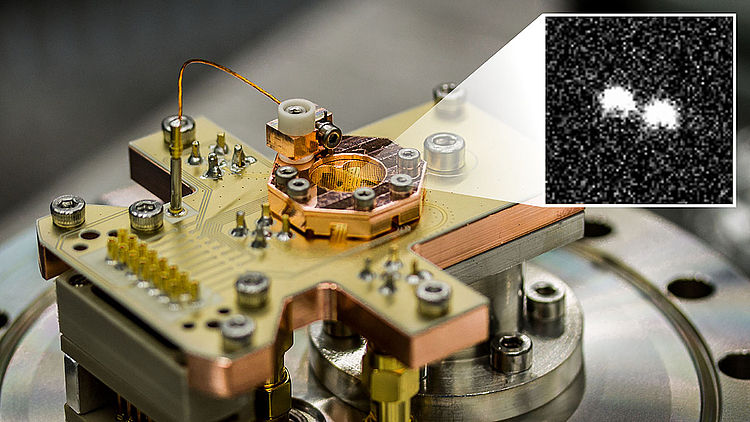Jan 13 2020
One of the most fascinating promises of quantum technology is a functional quantum computer. Quantum computers have considerably increased computing power, possessing the ability to solve tasks that otherwise cannot be handled by traditional computers.
 Interior of the apparatus in which the ions are trapped. The close-up shows an image of two single 9Be+ ions used for the quantum logic gates. Image Credit: Leibniz University Hannover.
Interior of the apparatus in which the ions are trapped. The close-up shows an image of two single 9Be+ ions used for the quantum logic gates. Image Credit: Leibniz University Hannover.
For example, interpreting and discovering novel pharmaceuticals or materials and also testing the limitations of cryptographic methods. Similar to traditional computers, the word quantum bit, or qubit for short, refers to the fundamental unit in quantum data.
Currently, trapped ions and superconducting circuits are the most sophisticated techniques for achieving qubits. While the trapped ions store quantum data in varying energy levels of single atoms, the superconducting circuits store quantum data in electronic components.
With the help of superconducting circuits, scientists have now successfully demonstrated that quantum computers are capable of carrying out extremely specialized tasks that otherwise cannot be handled by traditional computers. But contrary to any other technique, ions generate considerably lower rates of error during operations.
At the Physikalisch-Technische Bundesanstalt (PTB) and Leibniz University Hannover, scientists have currently developed a novel technique to further decrease the error rates and offer consistent operations relatively faster. The researchers’ findings have been reported in the latest issue of Physical Review Letters—a scientific journal.
The latest technique developed by the researchers involves utilizing electric fields above a chip structure to trap ions. To implement qubit operations, microwave signals are sent via unique conductor loops integrated into the chip structure. Logic operations are generally performed through laser beams that are controlled very carefully.
A benefit of using microwave fields is that they can be controlled more easily and are also a highly established technology, because they are ever-present in many different products ranging from mobile phones to planes.
Within the purview of this analysis, scientists analyzed the most efficient techniques for qubit operations. This also happens to be an extremely pertinent problem in traditional computer chips because the proportion of energy required for each operation decides the number of computer chips that can be processed every second before they begin to overheat.
The scientists successfully demonstrated the reduced error rates with respect to ion-trap microwave quantum computers. They showed that microwave pulses of a specific shape, where the field is switched on and off easily, generate 100 times lower error rates when compared to the pulses where the fields are merely turned on and off—with the same input of energy and in spite of the presence of noise.
Because of this reason, the researchers introduced extra noise, which was carefully regulated, into the experiment and established the operation errors for different injected noise levels and also for both shapes of pulses.
This made a huge difference for our experiment. In the past, finding suitable operations involved much trial and error as well as a long optimisation process before catching a moment with very little noise. All we have to do now is to switch on the experiment and it works.
Giorgio Zarantonello, Study Author, Leibniz University Hannover
After proving that it is viable to perform fundamental operations with reduced error rates, the scientists are currently planning to move their discoveries to more complex tasks. The aim is to realize less than one error in every 10,000 operations, which when upgrading to a huge number of qubits turns out to be efficient.
The researchers have already created a patented microfabrication technology for this task. The technology supports the exploitation and storage of a huge number of qubits in a chip structure.
The study was supported by the German Research Foundation (DFG) via the collaborative research center 1227 “DQ-mat,” which works on regulating quantum mechanical systems of complex nature.
The joint research center includes scientists focused in the fields of theoretical and experimental physics from the Centre of Applied Space Technology and Microgravity (ZARM) in Bremen, Leibniz University Hannover, and PTB Braunschweig. The work was also financed by the EU quantum technology flagship.
The EU and its member states are planning to invest one billion euros over the next decade to convert basic study findings in quantum physics into technology. The “MicroQC” project brings together scientists from Braunschweig, Hannover, Sofia, Jerusalem, Sussex, and Siegen.